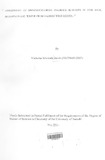| dc.description.abstract | The aim of this study was to investigate the levels of 17 organochlorine pesticide residues in
cow milk, water and sediments from Karen and Langata areas of Nairobi West region. Water,
sediment and milk were sampled using the standard operating procedures. The methods used
for extraction of the pesticide residues were; Soxhlet extraction for sediments and liquidliquid
partitioning for water and milk sample. The extracts were then cleaned up using a
column packed with alumina. The samples were analysed using Varian CP-3800 Gas
Chromatograph equipped with electron capture detector for detection of organochlorines
pesticides and statistical data was analysed using microsoft excel and Statistical Programme
for Social Sciences tools (SPSS).
The pesticides residues in milk varied from below detection limits to 3309 ng/kg.Milk from
Karinde had the highest I17 organochlorine pesticide at 2225.74 ng /kg while the other four
sites had lower concentrations which were: 1834.40 ng/kg for Maasai Plains, 1826.26 ng/kg
for 01epolos, 1748.09 ng/kg for Fare Acres and 1738.32 ng/kg for Bogani. The highest I17
organochlorine pesticides concentrations were recorded at and Bogani, they had 5639.29 ng
/kg and 5024 ng /kg respectively.
The average levels of pesticides in sediments ranged from below detection limit to 4238.71
ng /kg. The highest concentration in sediments was that of heptachlor epoxide at 2387.10 ng
.
/kg which was detected at the Co-operative College Bridge. The month of February had the
highest sum ofOC pesticides detected in sediments samples collected from Co-operative C01lege
Bridge site at 5064.55 ng /kg. The same site had the highest mean concentration detected
at 1587.77 ng/kg levels. Sediment samples from Ngong Bridge and Ongata Rongai Bridge had low mean concentration values recorded at 536.26 ng/kg and 522.8 ng/kg levels respectively.
Water samples had pesticide residue levels ranging from below detection limits to 141.S 1 ng/l
forp, p '- DDT from Co-operative College Bridge. Water samples from this site had the highest
mean organochlorine pesticides residue levels in February at 417.04 ng/l levels. The highest mean of organochlorine pestcides residues in water was 272.38 ng/I at Ngong bridge. On average the detection frequency of the pesticides varied from 36% for methoxychlor to 100%
for Aldrin.
The Pearson's con-elation coefficients as determined for the OCPs present between water and
sediment were positive at all the sites. The strongest and most significant intermatrix correlation
was observed at Cooperative bridge (I=0.696) followed by Ongata Rongai bridge
(1'=0.448) while that for Ngong bridge area was weak (1'=0.215), for all the sites p> 0.005.
Seasonal variation pattern was reflected in the three matrices, but higher values of residues
were recorded mostly during the short rain sea: on than the dry and long rain seasons.
In general, from the three matrices studied, milk samples had exceeded the FAO/ WfIO allowed
levels of pes~icides in November and December at Karinde and Bogani. High values
were also recorded in sediments from Co-operative College Bridge site during February as
compared to water at the same time.
This study shows the OCPs residues in the environmental media studied and milk which is
human food. Presence of OCPs residues in rn.lk implies that the consumers of milk and it
products are exposer; to dangers coursed h)' these residues which include cancers. This study
rcveais to the public health and other health stakeholder the residues status in Nairobi West region. Farmers who participated in the study will be advised on the methods to spraying
their animals in order to protect themselves from the pesticide contami ration. The data from
this study is added to the scientific data and knowledge on pesticide residue levels in cow
milk which was not' available for any of the Nairobi regions. | en |

